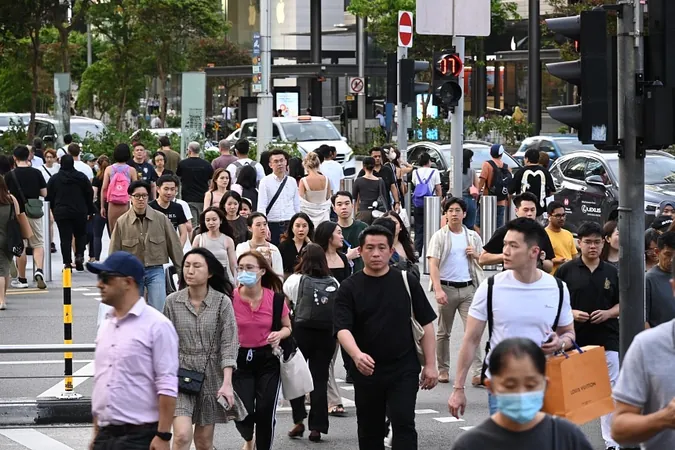
Singapore's Population Surpasses 6 Million: What Does This Mean for the Future?
2024-09-24
Author: Siti
Introduction
SINGAPORE – The Republic of Singapore has crossed a significant milestone with its total population reaching 6.04 million in June 2024, marking a 2% increase from June 2023. This is the first instance in history that the population has exceeded the six million threshold, according to the latest report from the National Population and Talent Division (NPTD), released on September 24.
Population Growth Factors
The surge in population can largely be attributed to a remarkable 5% growth in the non-resident segment, which climbed from 1.77 million to 1.86 million within just one year. Non-resident workers, including those on work permits and migrant domestic workers, are vital for maintaining essential services and filling roles that local job seekers are often reluctant to take, particularly in sectors like construction and caregiving.
Changing Employment Dynamics among Citizens
Meanwhile, Singaporean citizens are experiencing a shift in employment dynamics, leaning towards higher-paying jobs in fields such as finance, insurance, information technology, and professional services. This trend showcases a robust labor market with a low unemployment rate among residents.
Concerns Over Birth and Marriage Rates
However, the statistics reveal a concerning decrease in both births and marriages among citizens. Fewer citizens are choosing to marry and start families, while the aging population is becoming increasingly prominent, presenting potential challenges for the nation’s social structure in the coming years.
Citizen and Resident Population Growth
In detail, the report noted that the citizen population grew modestly by 0.7% from 3.61 million to 3.64 million, while the number of permanent residents increased by 1.2% from 538,600 to 544,900. Despite these increases, the proportion of seniors in the population is expanding, highlighting the urgent need for policies addressing aging-related issues.
Role of Non-residents
Experts like Mr. Christopher Gee from the Institute of Policy Studies (IPS) pointed out that having nearly one in three residents classified as non-residents is typical for major global cities. The foreign workforce comprises roughly two-thirds of non-resident figures, which include many semi-skilled workers as well as migrant domestic helpers who manage household tasks. These non-residents play a crucial role in filling labor shortages in various industries, significantly aiding the nation’s recovery and expansion post-COVID-19.
Projected Population Growth
In terms of projected growth, if the current trends continue, Singapore’s population could reach approximately 6.37 million by June 2030. This estimate remains below the government’s foresight of 6.5 to 6.9 million citizens as articulated in a White Paper back in 2013, which aimed to ensure adequate infrastructure and amenities for future residents.
Concerns Over Sustainability
However, experts caution that the rapid influx of non-residents versus the slower growth in residents raises concerns regarding the sustainability of public infrastructure and resources. Dr. Tan Poh Lin from IPS emphasized that while non-residents contribute positively to the tax base, the increasing population may place undue pressure on various public services.
Key Observations
Here are four critical observations from the report:
1. Aging Citizen Population
As of June 2024, 19.9% of citizens are aged 65 and older, up significantly from 12.4% in 2014. The number of citizens aged 80 and above skyrocketed from 85,000 to 142,000 over the same period—a startling 65% increase.
2. Decline in Citizen Births
The number of citizen births fell to 28,877 in 2023, marking a decrease of 5.1% from the previous year and a historic low fertility rate of 0.97.
3. Decrease in Citizen Marriages
There were 24,355 marriages among citizens in 2023, which, while slightly lower than the 2022 record, remains higher than pre-pandemic figures from 2019. However, the broader trend indicates a downward shift in the annual average.
4. Rising Transnational Marriages
Marriages between citizens and non-citizens rose to 36% of total citizen marriages in 2023, an increase from 33% in 2022. This trend highlights the growing interconnectedness of the population.
Conclusion
As experts urge local policymakers to prioritize social integration and equitable working conditions for migrant workers, Singapore's government faces the challenge of balancing a diverse demographic with sustainability and quality of life for its residents. The road ahead will require innovative solutions and foresight as the nation navigates these changes in its social fabric.





 Brasil (PT)
Brasil (PT)
 Canada (EN)
Canada (EN)
 Chile (ES)
Chile (ES)
 España (ES)
España (ES)
 France (FR)
France (FR)
 Hong Kong (EN)
Hong Kong (EN)
 Italia (IT)
Italia (IT)
 日本 (JA)
日本 (JA)
 Magyarország (HU)
Magyarország (HU)
 Norge (NO)
Norge (NO)
 Polska (PL)
Polska (PL)
 Schweiz (DE)
Schweiz (DE)
 Singapore (EN)
Singapore (EN)
 Sverige (SV)
Sverige (SV)
 Suomi (FI)
Suomi (FI)
 Türkiye (TR)
Türkiye (TR)